School-to-Work Transitions under Unequal Conditions: A Regionalised Perspective on the ‘Discouraged Worker’ Hypothesis
Abstract
:1. Introduction
Are young adults in regions with poor employment and vocational training opportunities more likely to aim at prolonging and, subsequently, at actually prolonging their general school careers? Are effects moderated by vocational training and school opportunities in the region?
2. Institutional Background
- (i)
- School-based VET is offered at vocational schools. It typically lasts two to four years and leads to a vocational qualification. The majority of school-based VET occupations are in the medical and social care sectors. To enrol in these training types, a Realschule degree is often required, and in practice, a considerable share (26%) of trainees even hold an Abitur (BIBB 2020, p. 178).
- (ii)
- The “transition system” comprises vocational preparatory courses, which provide individuals with the skills and knowledge needed to enter an apprenticeship. These courses typically last one year but do not provide young adults with a formal vocational qualification. In fact, participation rates have declined since the mid-2000s, but the high share of youth in the transition system has remained a controversial issue (Severing 2010).
- (iii)
- Apprenticeship training, also known as dual education, is the most common path for young people to obtain a vocational qualification. In 2020, approximately 45% (around 500,000 individuals) of those eligible for VET started apprenticeships (BIBB 2020, p. 123). This combines on-the-job training with classroom instruction, allowing individuals to gain both practical experience and general knowledge in a specific occupation. Apprenticeships in Germany typically last three to four years and are available in a wide range of fields. Apprentices are paid by their employers for their work, but they receive a reduced rate of pay during their training period. Moreover, apprenticeships often offer a direct path into employment, with 77% of apprentices securing full-time employment with the company with which they are trained (ibid.).
3. Theoretical Arguments and Hypotheses
3.1. Regional Availability of VET Opportunities
3.2. Heterogeneity in the Influence of Regional Socioeconomic Conditions
3.3. Spatial Aggregations
4. Data and Methods
4.1. Survey Data: The German National Educational Panel Study (NEPS)
- (i)
- Aspirations to continue education in general school. This information was collected in the last regular school year (i.e., at latest in the year 2011 for SC4 and in the year 2015 for SC3.
- (ii)
- Actual continuation of education in general school compared with entering VET after the last regular year of school.
4.2. Administrative Data: Regional Information
4.3. Linking Survey Data with Administrative Regional Data
4.4. Analytical Methods
5. Results and Discussion
5.1. Regional Conditions and the DWE
5.2. Heterogenous Effects of Regional Unemployment
5.3. Summary
5.4. Limitations
6. Conclusions
Author Contributions
Funding
Institutional Review Board Statement
Informed Consent Statement
Data Availability Statement
Acknowledgments
Conflicts of Interest
Appendix A
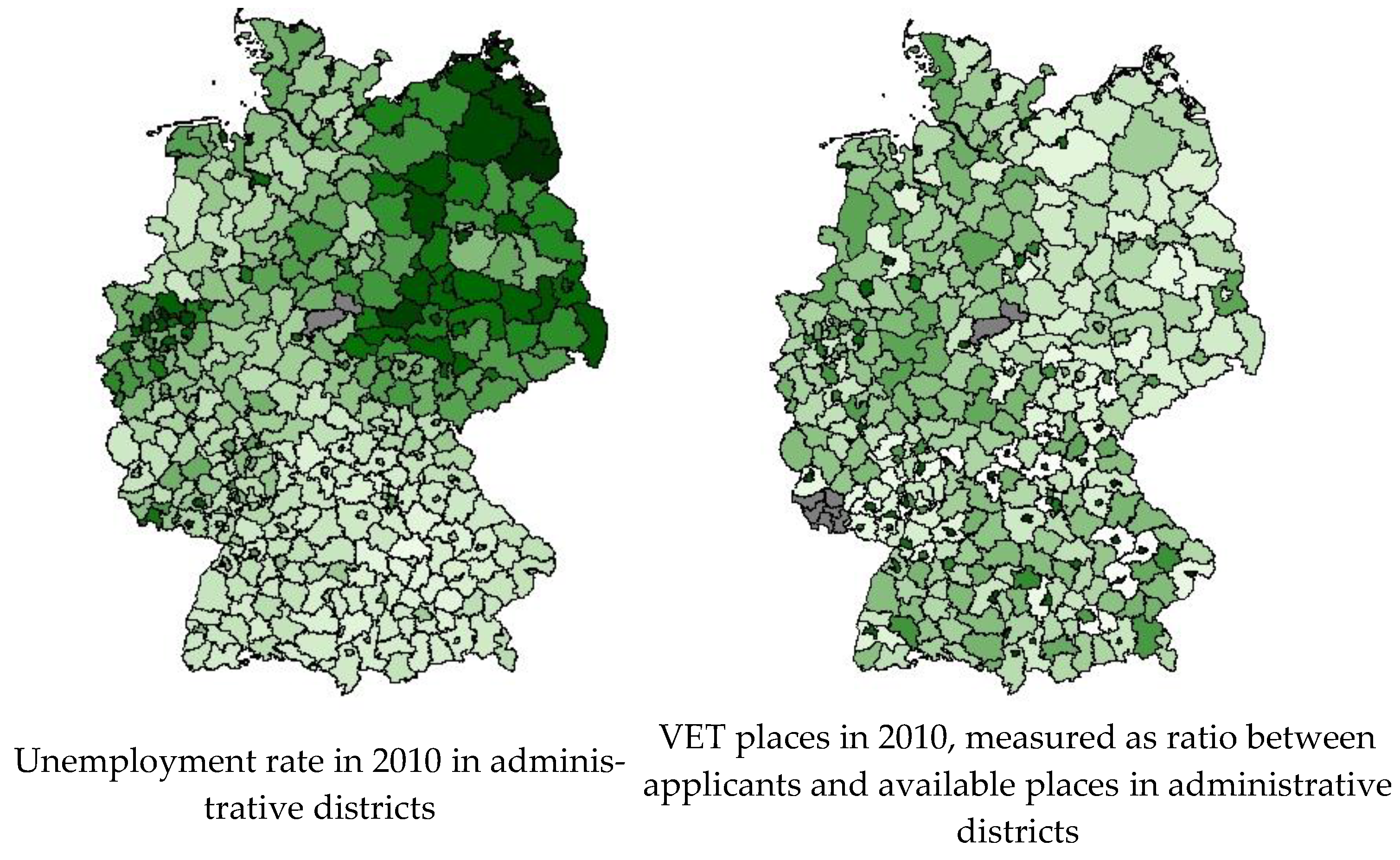
| Share of Students in Full Time School Based VET by All Students in VET in 2010 | Share of Students in Full Time School Based VET by All Students in VET in 2014 | Unemployment Rate in 2010 | Unemployment Rate in 2014 | Share of Realschule and Abitur Graduates 2010 by Population in 1000 | Share Realschule and Abitur Graduates 2014 by Population in 1000 | VET Places in 2010; Ratio between Applicants and Available Places | |
|---|---|---|---|---|---|---|---|
| Share of students in full time school based VET by all students in VET in 2010 | 1 | ||||||
| Share of students in full time school based VET by all students in VET in 2014 | 0.7739 | 1 | |||||
| Unemployment rate in 2010 | 0.0656 | 0.144 | 1 | ||||
| Unemployment rate in 2014 | 0.0802 | 0.1526 | 0.9642 | 1 | |||
| Share of Realschule and Abitur graduates by population in 1000 in 2010 | −0.048 | −0.048 | −0.0105 | −0.004 | 1 | ||
| Share Realschule and Abitur graduates by population in 1000 in 2010 | −0.0972 | −0.1133 | 0.0013 | 0.0146 | 0.8438 | 1 | |
| VET places in 2010; ratio between applicants and available places | −0.1109 | −0.1101 | 0.7129 | 0.5998 | 0.1889 | 0.2627 | 1 |
| VET places in 2014; ratio between applicants and available places | −0.1312 | −0.1112 | 0.6764 | 0.6754 | 0.1889 | 0.1845 | 0.9542 |
| 1 | This paper uses data from the National Educational Panel Study (NEPS): Starting Cohort 3–5th Grade, http://dx.doi.org/10.5157/NEPS:SC3:12.0.0, and Starting Cohort 4–9th graders, http://dx.doi.org/10.5157/NEPS:SC4:12.0.0. From 2008 to 2013, NEPS data were collected as part of the Framework Programme for the Promotion of Empirical Educational Research funded by the German Federal Ministry of Education and Research (BMBF). As of 2014, the NEPS survey is carried out by the Leibniz Institute for Educational Trajectories (LIfBi) at the University of Bamberg, in cooperation with a nationwide network. |
References
- Albert, Cecilia. 2000. Higher education demand in Spain: The influence of labour market signals and family background. Higher Education 40: 147–62. [Google Scholar] [CrossRef]
- Anselin, Luc, and Raymond J. G. M. Florax, eds. 2012. New Directions in Spatial Econometrics. Berlin and Heidelberg: Springer. [Google Scholar]
- Battey, Heather S., David R. Cox, and Michelle V. Jackson. 2019. On the linear in probability model for binary data. Royal Society Open Science 6: 190067. [Google Scholar] [CrossRef]
- BBSR. 2023. Indikatoren und Karten zur Raum- und Stadtentwicklung. Ausgabe 2022. Khabarovsk Territory: INKAR. [Google Scholar]
- BIBB. 2020. Datenreport zum Berufsbildungsbericht 2020. Informationen und Analysen zur Entwicklung der beruflichen Bildung. Available online: http://datenreport.bibb.de/media2012/BIBB_Datenreport_2012.pdf (accessed on 18 September 2023).
- Biggart, Andy, and Andy Furlong. 1996. Educating “discouraged workers”: Cultural diversity in the upper secondary school. British Journal of Sociology of Education 17: 253–66. [Google Scholar] [CrossRef]
- Blommaert, Lieselotte, Marcel Coenders, and Frank Van Tubergen. 2014. Ethnic discrimination in recruitment and decision makers’ features: Evidence from laboratory experiment and survey data using a student sample. Social Indicators Research 116: 731–54. [Google Scholar] [CrossRef]
- Blossfeld, Hans-Peter, and Hans-Günther Roßbach, eds. 2019. Education as a Lifelong Process: The German National Educational Panel Study (NEPS), 2nd ed. Berlin and Heidelberg: Springer. [Google Scholar]
- Blossfeld, Hans-Peter, Hans-Günther Rossbach, and Jutta Von Maurice. 2011. Education as a Lifelong Process—The German National Educational Panel Study (NEPS). In Zeitschrift Für Erziehungswissenschaft. Berlin and Heidelberg: Springer. [Google Scholar]
- Brunello, Giorgio. 2009. The effect of economic downturns on apprenticeships and initial workplace training: A review of the evidence. Empirical Research in Vocational Education and Training 1: 145–71. [Google Scholar] [CrossRef]
- Buchmann, Claudia, and Hyunjoon Park. 2009. Stratification and the formation of expectations in highly differentiated educational systems. Research in Social Stratification and Mobility 27: 245–67. [Google Scholar] [CrossRef]
- Clark, Damon. 2002. The Impact of Local Labour Market Conditions on Participation in Further Education in England (IZA Discussion Papers No. 550). Bonn: Institute of Labour Economics (IZA). [Google Scholar] [CrossRef]
- Dellas, Harris, and Plutarchos Sakellaris. 2003. On the cyclicality of schooling: Theory and evidence. Oxford Economic Papers 55: 148–72. [Google Scholar] [CrossRef]
- Destatis. 2023. Statistik der Beruflichen Schulen. Fachserie 11 Reihe 2. 21121-01-05-4: Schulen, Schüler nach Schularten—Stichtag: Schuljahresbeginn—Regionale Tiefe: Kreise und krfr. Städte. Available online: https://www.destatis.de/DE/Service/Bibliothek/_publikationen-fachserienliste-11.html (accessed on 18 September 2023).
- Di Stasio, Valentina. 2014. Education as a signal of trainability: Results from a vignette study with Italian employers. European Sociological Review 30: 796–809. [Google Scholar] [CrossRef]
- Euler, Dieter. 2022. Die Rolle des Berufskollegs im Nordrhein-Westfälischen Bildungssystem. Düsseldorf: Ministerium für Schule und Bildung des Landes Nordrhein-Westfalen. [Google Scholar]
- Finger, Claudia. 2016. Institutional constraints and the translation of college aspirations into intentions—Evidence from a factorial survey. Research in Social Stratification and Mobility 46: 112–28. [Google Scholar] [CrossRef]
- Flohr, Matthias, Laura Menze, and Paula Protsch. 2020. Occupational aspirations in the context of regional occupational structures. Kölner Zeitschrift für Soziologie und Sozialpsychologie 72: 79–104. [Google Scholar] [CrossRef]
- Fotheringham, A. Stewart, and David W. S. Wong. 1991. The modifiable areal unit problem in multivariate statistical analysis. Environment and Planning A 23: 1025–44. [Google Scholar] [CrossRef]
- Gibbons, Stephen, and Anna Vignoles. 2012. Geography, choice and participation in higher education in England. Regional Science and Urban Economics 41: 98–113. [Google Scholar] [CrossRef]
- Hartung, Andreas, Katarina Weßling, and Steffen Hillmert. 2022. Interplay between family background and labour-market conditions in shaping students’ occupational status expectations. Journal of Education and Work 35: 405–21. [Google Scholar] [CrossRef]
- Herzer, Philip, and Joachim G. Ulrich. 2020. Wie die regionale Mobilität von Jugendlichen zur Besetzung von Ausbildungsplätzen beiträgt (BIBB-Report 5/2020). Bundesinstitut für Berufsbildung (BIBB). Available online: https://www.bibb.de/dienst/publikationen/de/download/16748 (accessed on 4 July 2023).
- Hillmert, Steffen, Andreas Hartung, and Katarina Weßling. 2017. A decomposition of local labour-market conditions and their relevance for inequalities in transitions to vocational training. European Sociological Review 33: 534–50. [Google Scholar] [CrossRef]
- Karaca-Mandic, Pinar, Edward C. Norton, and Bryan Dowd. 2012. Interaction terms in nonlinear models. Health Services Research 47: 255–74. [Google Scholar] [CrossRef] [PubMed]
- Kleinert, Corinna, and Marita Jacob. 2012. Strukturwandel des Übergangs in eine berufliche Ausbildung. In Soziologische Bildungsforschung, Kölner Zeitschrift für Soziologie und Sozialpsychologie, Sonderhefte. Edited by Rolf Becker and Heike Solga. Berlin and Heidelberg: Springer, vol. 52, pp. 211–33. [Google Scholar] [CrossRef]
- Kwan, Mei-Po. 2012. The uncertain geographic context problem. Annals of the Association of American Geographers 102: 958–68. [Google Scholar] [CrossRef]
- Méndez, Fabio, and Facundo Sepúlveda. 2012. The cyclicality of skill acquisition: Evidence from panel data. American Economic Journal: Macroeconomics 4: 128–52. [Google Scholar] [CrossRef]
- Micklewright, John, Mark Pearson, and Stephen Smith. 1990. Unemployment and early school leaving. The Economic Journal 100: 163–69. [Google Scholar] [CrossRef]
- Muehlemann, Samuel, and Stefan C. Wolter. 2011. Firm-sponsored training and poaching externalities in regional labor markets. Regional Science and Urban Economics 41: 560–70. [Google Scholar] [CrossRef]
- Muehlemann, Samuel, Stefan C. Wolter, and Adrian Wueest. 2009. Apprenticeship training and the business cycle. Empirical Research in Vocational Education and Training 2: 173–86. [Google Scholar] [CrossRef]
- NEPS Network. 2021. National Educational Panel Study, Scientific Use File of Starting Cohort Grade 9. Bamberg: Leibniz Institute for Educational Trajectories (LIfBi). [Google Scholar] [CrossRef]
- NEPS Network. 2022. National Educational Panel Study, Scientific Use File of Starting Cohort Grade 5. Bamberg: Leibniz Institute for Educational Trajectories (LIfBi). [Google Scholar] [CrossRef]
- Protsch, Paula, and Heike Solga. 2015. The social stratification of the German VET system. Journal of Education and Work 29: 637–61. [Google Scholar] [CrossRef]
- Raffe, David, and J. Douglas Willms. 1989. Schooling the discouraged worker: Local-labour-market effects on educational participation. Sociology 23: 559–81. [Google Scholar] [CrossRef]
- Rice, Patricia. 1999. The impact of local labour markets on investment in further education: Evidence from the England and Wales youth cohort studies. Journal of Population Economics 12: 287–312. [Google Scholar] [CrossRef]
- Salazar, Leire, Héctor Cebolla-Boado, and Jonas Radl. 2020. Educational expectations in the great recession: Has the impact of family background become stronger? Socio-Economic Review 18: 465–91. [Google Scholar] [CrossRef]
- Severing, Eckart. 2010. Berufsausbildung in Deutschland—Zu wenige Fachkräfte für die Wirtschaft und zu viele Jugendliche ohne Ausbildungsperspektive. In Das Berufsbildungssystem in Deutschland. Edited by Gerhard Bosch, Sikrit Krone and Dirk Langer. Berlin and Heidelberg: VS Verlag für Sozialwissenschaften, pp. 91–99. [Google Scholar] [CrossRef]
- Sievertsen, Hans Henrik. 2016. Local unemployment and the timing of post- secondary schooling. Economics of Education Review 50: 17–28. [Google Scholar] [CrossRef]
- Steinhauer, Hans Walter, Sabine Zinn, Christoph Gaasch, and Solange Goßmann. 2016. NEPS Technical Report for Weighting: Weighting the Sample of Kindergarten Children and Grade 1 Students of the National Educational Panel Study (Wave 1 to 3) NEPS Working Paper No. 66. Bamberg: LifBi. Available online: https://www.neps-data.de/Portals/0/Working%20Papers/WP_LXVI.pdf (accessed on 18 September 2023).
- Tumino, Alberto. 2013. The Effect of Local Labour Market Conditions on Educational Choices: A Cross Country Comparison. ImPRovE Working Papers 13/06. Belgium: Herman Deleeck Centre for Social Policy, University of Antwerp. [Google Scholar]
- van Ham, Maarten, Clara H. Mulder, and Pieter Hooimeijer. 2001. Local underemployment and the discouraged worker effect. Urban Studies 38: 1733–51. [Google Scholar] [CrossRef]
- Wagner, Karin. 1999. The German apprenticeship system under strain. In The German Skills Machine: Sustaining Comparative Advantage in a Global Economy. Edited by Pepper. D. Culpepper and David Finegold. New York: Berghahn Books, pp. 37–76. [Google Scholar]
- Weßling, Katarina, and Nora Bechler. 2019. Where do regional influences matter? The impact of socio-spatial indicators on transitions from secondary school to university. Review of Regional Research 39: 163–88. [Google Scholar] [CrossRef]
- Weßling, Katarina, and Alexandra Wicht. 2015. Möglichkeiten der Nutzung regionaler Daten im Nationalen Bildungspanel—Ein Überblick. NEPS Working Papers No. 54. Bamberg: LifBi. Available online: https://www.neps-data.de/Portals/0/Working%20Papers/WP_LIV.pdf (accessed on 18 September 2023).
- Weßling, Katarina, Andreas Hartung, and Steffen Hillmert. 2015. Spatial structure counts: The relevance of regional labour-market conditions for educational transitions to vocational training. Empirical Research in Vocational Education and Training 7: 12. [Google Scholar] [CrossRef]
- Wicht, Alexandra, Per Kropp, and Barbara Schwengler. 2019. Are functional regions more homogeneous than administrative regions? A test using hierarchical linear models. Papers in Regional Science 99: 135–64. [Google Scholar] [CrossRef]
- Wooldridge, Jeffrey M. 2006. Introductory Econometrics: A Modern Approach, 2nd ed. Dallas: South-Western. [Google Scholar]

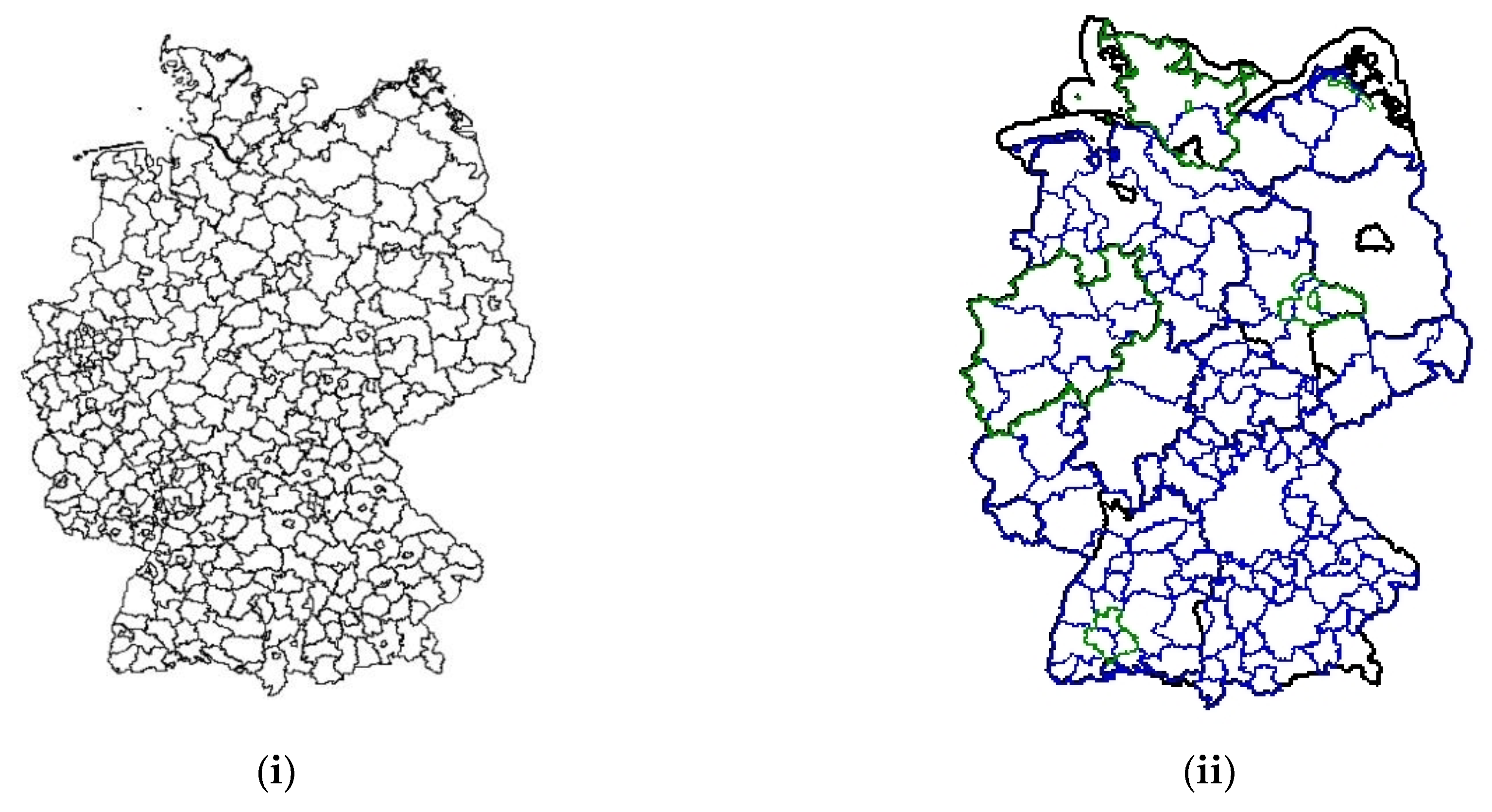

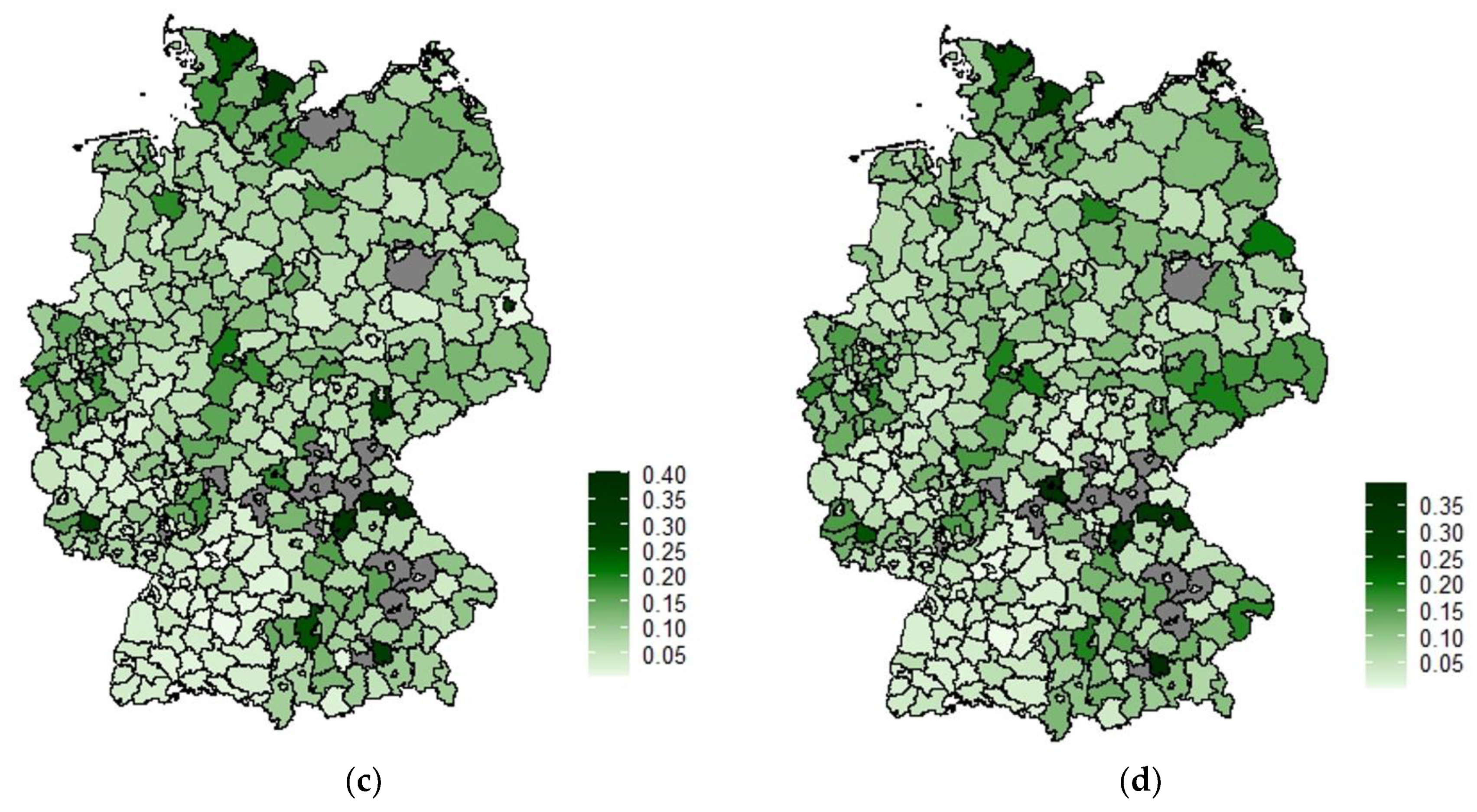

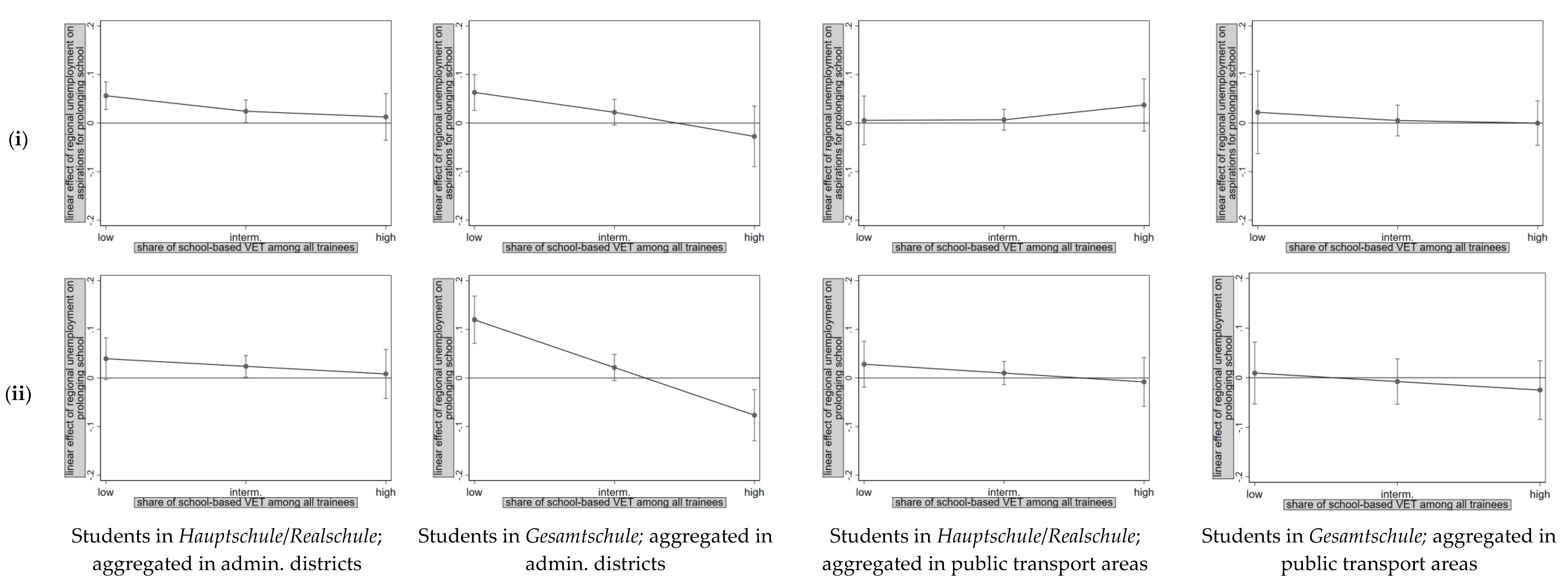
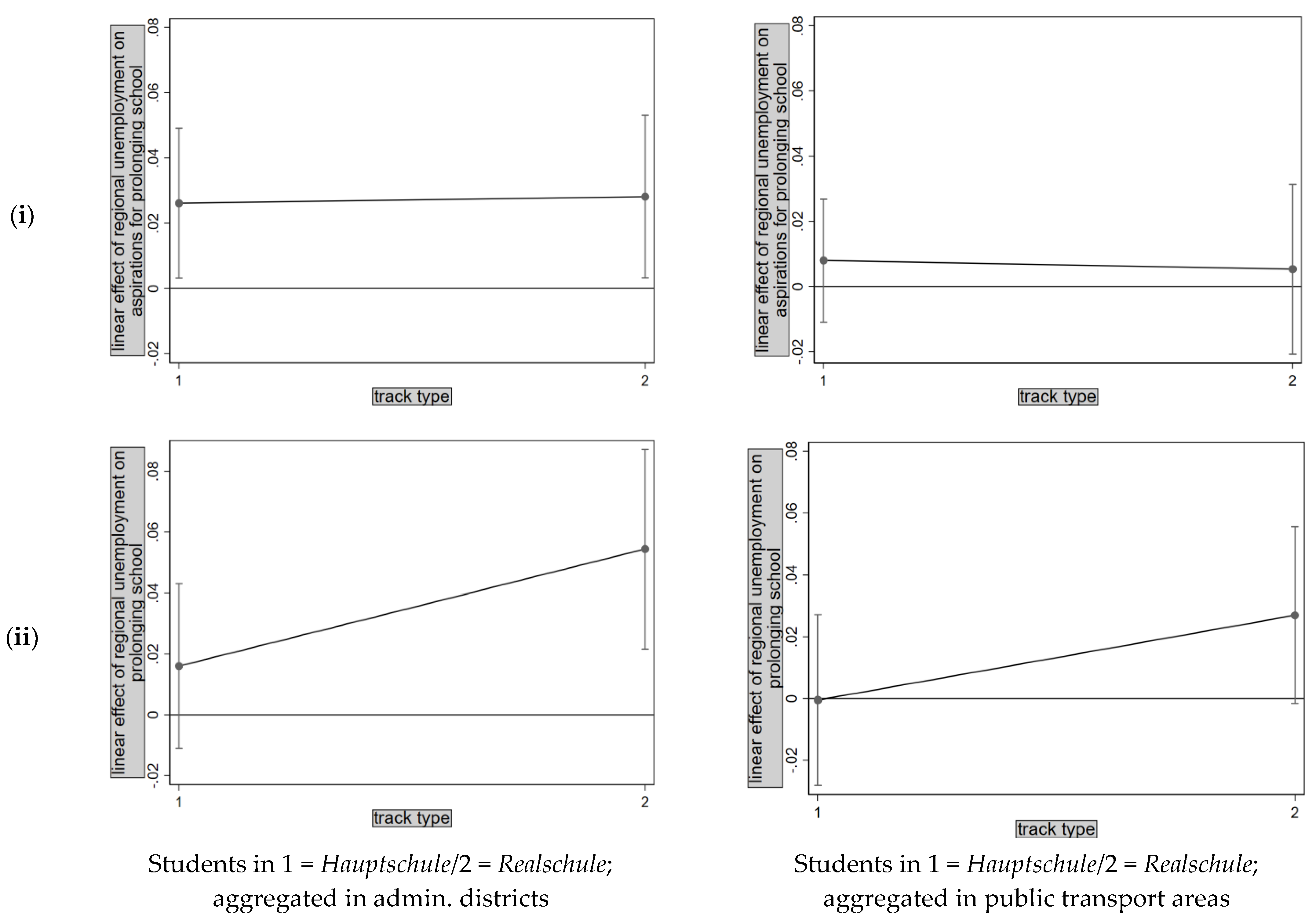

| Mean (SD), Min–Max/% | |
|---|---|
| Unemployment rate in district | 5.5 (2.9), 1.0–15.0 |
| Unemployment rate in public transport area | 5.9 (2.3), 2.1–13.1 |
| Share of school VET in district | 0.08 (0.05), 0.004–0.402 |
| Share of school VET in public transport area | 0.07 (0.03), 0.014–0.185 |
| High share of RS/ABI graduates in district | 7.6% |
| Gesamtschule in federal state | 59.5% |
| NEPS Cohort: SC4 in 2010 | 80.3% |
| NEPS Cohort: SC3 in 2014 | 19.7% |
| Attended school track: Hauptschule | 26.9% |
| Attended school track: Realschule | 38.9% |
| Attended school track: Gesamtschule | 34.2% |
| Sex: female | 46.9% |
| Migration background: student or at least one parent of foreign descent | 20.1% |
| Parents: at least one w/higher education | 16.75% |
| Age in years | 16.5 (0.7), 14–19 |
| Grade in German (rev.) | 4.1 (0.8), 1–6 |
| Grade in Math (rev.) | 4.1 (1.0), 1–6 |
| N | 4115 |
| Gesamtschule | Hauptschule/Realschule | |||||||||||
|---|---|---|---|---|---|---|---|---|---|---|---|---|
| (i) Aspirations | (ii) Transition | (i) Aspirations | (ii) Transition | |||||||||
| 1. Unemp. | 2. Unemp+ Indv. | 3. Unemp+ Indv.+ Context | 4. Unemp. | 5. Unemp+ Indv. | 6. Unemp+ Indv.+ Context | 7. Unemp. | 8. Unemp+ Indv. | 9. Unemp+ Indv.+ Context | 10. Unemp. | 11. Unemp+ Indv. | 12. Unemp+ Indv.+ Context | |
| Regional unemployment rate (percent) | −0.033 ** (0.002) | −0.029 ** (0.002) | −0.006 (0.637) | −0.005 (0.709) | −0.006 (0.605) | −0.011 (0.469) | 0.016 ** (0.032) | 0.033 ** (0.002) | 0.031 ** (0.008) | 0.015 (0.182) | 0.012 (0.270) | 0.010 (0.402) |
| Attended school track: Realschule (ref.: Hauptschule) | 0.086 * (0.024) | 0.113 ** (0.004) | 0.104 ** (0.007) | 0.026 (0.562) | 0.026 (0.559) | 0.019 (0.679) | ||||||
| Survey year: 2010 (NEPS-SC4) (ref.: 2014 (NEPS-SC3)) | −0.009 (0.895) | −0.002 (0.975) | 0.356 *** (0.000) | 0.395 *** (0.000) | 0.025 (0.621) | 0.058 (0.253) | −0.114 * (0.043) | −0.146 * (0.032) | ||||
| Sex: female (ref. male) | 0.013 (0.797) | 0.011 (0.817) | 0.032 (0.486) | 0.017 (0.708) | 0.073 * (0.014) | 0.074 ** (0.010) | 0.078 ** (0.006) | 0.077 ** (0.005) | ||||
| Migration background: student or at least one parent of foreign descent (ref. no migration background) | 0.161 ** (0.006) | 0.093 (0.097) | 0.154 ** (0.004) | 0.110 * (0.030) | 0.102 ** (0.003) | 0.112 *** (0.001) | 0.079 * (0.021) | 0.072 * (0.040) | ||||
| Parents: at least one with higher education | 0.137 ** (0.003) | 0.105 * (0.015) | 0.062 (0.259) | 0.044 (0.378) | 0.096 * (0.035) | 0.095 * (0.034) | 0.075 (0.844) | 0.070 (0.380) | ||||
| Age in years | −0.122 *** (0.000) | −0.111 *** (0.000) | −0.065 * (0.027) | −0.065 * (0.025) | −0.085 *** (0.000) | −0.081 *** (0.000) | −0.037 * (0.019) | −0.041 * (0.049) | ||||
| Grade in German (reversed coding 1−6) | 0.111 *** (0.000) | 0.111 *** (0.000) | 0.116 *** (0.000) | 0.107 *** (0.000) | 0.111 *** (0.000) | 0.106 *** (0.000) | −0.014 (0.539) | −0.018 (0.395) | ||||
| Grade in Mathematics (reversed coding 1−6) | −0.006 (0.816) | −0.009 (0.684) | 0.007 (0.756) | 0.007 (0.764) | 0.038 * (0.012) | 0.038 * (0.010) | 0.026 * (0.046) | 0.029 * (0.024) | ||||
| Federal state with Gesamtschule | 0.064 (0.180) | −0.033 (0.709) | ||||||||||
| Share of students in full-time school-based training in the region (admin. district) | −0.080 (0.325) | −0.202 (0.120) | −0.121 *** (0.000) | −0.099 (0.058) | ||||||||
| High share of students with Realschule degree/Abitur in the region (admin. district) | 0.148 (0.210) | −0.350 (0.058) | 0.022 (0.617) | 0.161 * (0.039) | ||||||||
| Constant | 0.728 *** (0.000) | 2.185 *** (0.000) | 2.103 *** (0.000) | 0.327 ** (0.003) | 1.170 * (0.018) | 1.730 *** (0.001) | 0.249 *** (0.000) | 0.885 ** (0.005) | 0.915 ** (0.003) | 0.137 (0.051) | 0.753 * (0.046) | 0.841 * (0.022) |
| N | 1421 | 1421 | 1421 | 1324 | 1324 | 1324 | 2694 | 2694 | 2694 | 2546 | 2546 | 2546 |
| R2 | 0.029 | 0.137 | 0.175 | 0.001 | 0.164 | 0.208 | 0.012 | 0.097 | 0.112 | 0.007 | 0.034 | 0.055 |
| Gesamtschule | Hauptschule/Realschule | |||||||||||
|---|---|---|---|---|---|---|---|---|---|---|---|---|
| (i) Aspirations | (ii) Transition | (i) Aspirations | (ii) Transition | |||||||||
| 1. Unemp. | 2. Unemp+ Indv. | 3. Unemp+ Indv.+ Context | 4. Unemp. | 5. Unemp+ Indv. | 6. Unemp+ Indv.+ Context | 7. Unemp. | 8. Unemp+ Indv. | 9. Unemp+ Indv.+ Context | 10. Unemp. | 11. Unemp+ Indv. | 12. Unemp+ Indv.+ Context | |
| Regional unemployment rate (percent) | −0.061 *** (0.000) | −0.054 *** (0.000) | 0.003 (0.857) | −0.025 (0.200) | −0.020 (0.274) | −0.014 (0.430) | 0.010 (0.344) | 0.017 (0.082) | 0.004 (0.692) | 0.004 (0.752) | 0.007 (0.543) | 0.011 (0.483) |
| Attended school track: Realschule (ref.: Hauptschule) | 0.129 ** (0.002) | 0.161 *** (0.000) | 0.155 *** (0.000) | 0.088 * (0.045) | 0.108 * (0.015) | 0.105 * (0.017) | ||||||
| Survey year: 2010 (NEPS-SC4) (ref.: 2014 (NEPS-SC3)) | −0.112 (0.072) | −0.088 (0.141) | −0.226 ** (0.004) | −0.267 ** (0.001) | 0.002 (0.971) | 0.037 (0.548) | 0.012 (0.874) | 0.009 (0.906) | ||||
| Sex: female (ref. male) | −0.011 (0.810) | −0.021 (0.651) | 0.018 (0.700) | −0.004 (0.928) | 0.063 * (0.034) | 0.065 * (0.026) | 0.062 * (0.039) | 0.056 * (0.045) | ||||
| Migration background: student or at least one parent of foreign descent (ref. no migration background) | 0.046 (0.435) | 0.011 (0.838) | 0.049 (0.474) | 0.011 (0.866) | 0.118 *** (0.000) | 0.121 *** (0.000) | 0.054 (0.117) | 0.049 (0.152) | ||||
| Parents: at least one with higher education | 0.136 ** (0.008) | 0.112 * (0.024) | 0.150 * (0.015) | 0.130 * (0.019) | 0.043 (0.339) | 0.038 (0.403) | 0.028 (0.550) | 0.028 (0.548) | ||||
| Age in years | −0.107 ** (0.002) | −0.097 ** (0.003) | −0.055 (0.134) | −0.052 (0.137) | −0.089 *** (0.000) | −0.089 *** (0.000) | −0.058 ** (0.007) | −0.065 ** (0.002) | ||||
| Grade in German (reversed coding 1−6) | 0.084 ** (0.004) | 0.080 ** (0.005) | 0.092 * (0.012) | 0.088 * (0.012) | 0.117 *** (0.000) | 0.115 *** (0.000) | −0.006 (0.784) | −0.010 (0.612) | ||||
| Grade in Mathematics (reversed coding 1−6) | 0.018 (0.452) | 0.021 (0.361) | 0.016 (0.469) | 0.013 (0.563) | 0.030 (0.059) | 0.028 (0.077) | 0.012 (0.382) | 0.015 (0.260) | ||||
| Federal state with Gesamtschule | 0.081 (0.132) | −0.002 (0.970) | ||||||||||
| Share of students in full-time school-based training in the region (admin. district) | −0.809 (0.504) | −1.88 (0.145) | −0.183 * (0.026) | −0.265 (0.681) | ||||||||
| High share of students with Realschule degree/Abitur in region (admin. district) | 0.016 (0.782) | 0.041 (0.436) | −0.009 (0.863) | 0.214 ** (0.005) | ||||||||
| Constant | 1.003 *** (0.000) | 2.343 *** (0.000) | 1.996 *** (0.000) | 0.514 ** (0.002) | 1.065 (0.082) | 1.409 * (0.025) | 0.351 *** (0.000) | 1.184 *** (0.000) | 1.177 *** (0.000) | 0.185 ** (0.002) | 1.135 ** (0.002) | 1.140 ** (0.002) |
| N | 1142 | 1142 | 1142 | 1064 | 1064 | 1064 | 2329 | 2329 | 2329 | 2199 | 2199 | 2199 |
| R2 | 0.062 | 0.148 | 0.175 | 0.012 | 0.125 | 0.173 | 0.018 | 0.112 | 0.113 | 0.011 | 0.053 | 0.054 |
Disclaimer/Publisher’s Note: The statements, opinions and data contained in all publications are solely those of the individual author(s) and contributor(s) and not of MDPI and/or the editor(s). MDPI and/or the editor(s) disclaim responsibility for any injury to people or property resulting from any ideas, methods, instructions or products referred to in the content. |
© 2023 by the authors. Licensee MDPI, Basel, Switzerland. This article is an open access article distributed under the terms and conditions of the Creative Commons Attribution (CC BY) license (https://creativecommons.org/licenses/by/4.0/).
Share and Cite
Wessling, K.; Hartung, A.; Hillmert, S. School-to-Work Transitions under Unequal Conditions: A Regionalised Perspective on the ‘Discouraged Worker’ Hypothesis. Soc. Sci. 2023, 12, 547. https://doi.org/10.3390/socsci12100547
Wessling K, Hartung A, Hillmert S. School-to-Work Transitions under Unequal Conditions: A Regionalised Perspective on the ‘Discouraged Worker’ Hypothesis. Social Sciences. 2023; 12(10):547. https://doi.org/10.3390/socsci12100547
Chicago/Turabian StyleWessling, Katarina, Andreas Hartung, and Steffen Hillmert. 2023. "School-to-Work Transitions under Unequal Conditions: A Regionalised Perspective on the ‘Discouraged Worker’ Hypothesis" Social Sciences 12, no. 10: 547. https://doi.org/10.3390/socsci12100547
APA StyleWessling, K., Hartung, A., & Hillmert, S. (2023). School-to-Work Transitions under Unequal Conditions: A Regionalised Perspective on the ‘Discouraged Worker’ Hypothesis. Social Sciences, 12(10), 547. https://doi.org/10.3390/socsci12100547





